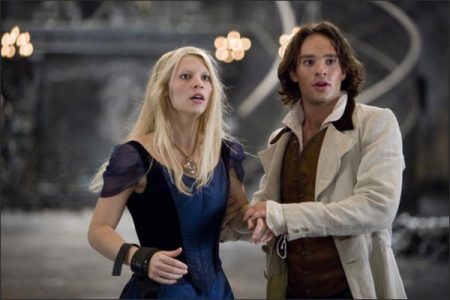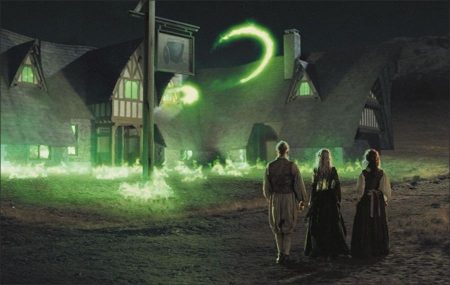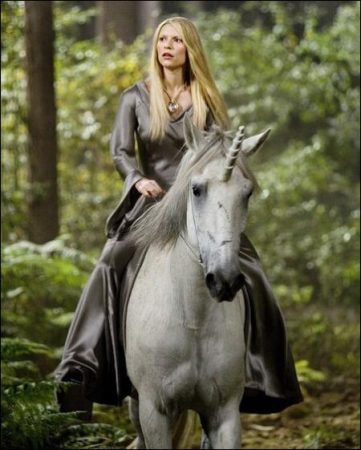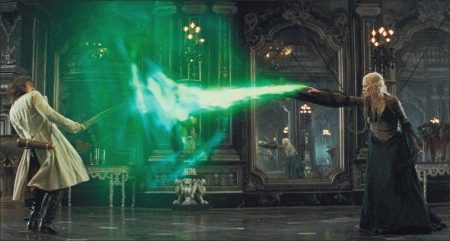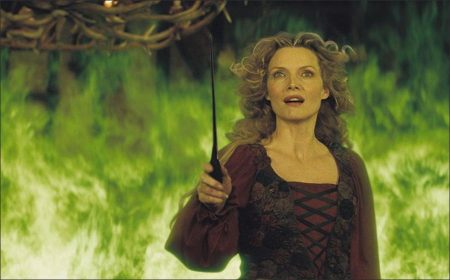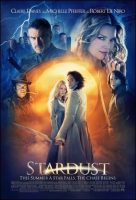“I thought it was one of the most wonderful, original stories I’d ever read,” he recalls. “And as a director, I’m mainly interested in telling stories, which seems like a forgotten art in modern movies. This was clearly a story that was meant to be made as a film.”
Inspired by the magic Gaiman had created on the page, Vaughn sought out the writer’s blessing. For his part, Gaiman had so far resisted handing out the rights to Stardust, but couldn’t help but have his mind changed by Vaughn’s obvious love for the material and exuberantly creative ideas. “Most of all, I trusted him,” says Gaiman.
With Gaiman backing him, Vaughn next set out to draft a screenplay adaptation that would make the writer’s characters come to flesh-and-blood life on the screen. He started by taking Gaiman’s advice to seek out the British novelist/screenwriter Jane Goldman, who has been celebrated as one of England’s most inventive new writers for her novel Dreamland, and served as the presenter of the popular UK television series “Jane Goldman Investigates,” in which she explored the enigma of the paranormal, from ghosts to ESP. Gaiman hoped that Goldman would bring her innate sense of romance, mystery and humanity to the story, while Vaughn would contribute an overarching creative vision for how the many-stranded quest to possess the star Yvaine could unfold at a blistering pace in two hours of visually stunning screen time. The partnership unfolded in just that way.
“Our goal in the adaptation was to keep the story as faithful to the book as possible while, at the same time, making it more cinematic and using a bit of our own poetic license to ensure that audiences will have a fantastic ride,” Vaughn explains.
Goldman notes that the duo focused on providing, with no holds barred, all the storytelling pyrotechnics any fairy tale lover ever lusted after – but also inserted a few more down-to-earth observations about life, as the best fairy tales always do. “Inside this incredible adventure are a lot of ideas about identity and fitting in and following your heart, which I think are things that everyone can relate to in real life,” she says.
The story’s ultimate mix of the relatably real journey of a young man coming of age blended with the fantastical tale of witches, ghosts and dashing royalty all trying to kidnap a mystical fallen star with a razor-sharp wit paid off. When Neil Gaiman read the first draft of the screenplay, his support for the project grew even stronger. “It was thrillingly exciting for me because it was quite good,” he says. “It was funny and scary and had a very filmic quality to it.” Gaiman now joined forces with Vaughn and Goldman to develop the screenplay even further – each pushing the other’s imaginations to a further edge.
When the screenplay was finally complete, the man who then came long to put the feature film into fast forward was producer Lorenzo di Bonaventura, who, perhaps not surprisingly, was also involved in taking the beloved Harry Potter from novel to motion picture blockbuster and family classic. Di Bonaventura was instantly impressed with the film’s vision.
“The script was an extraordinary piece of material that successfully intermeshed many different tones,” he says. “There was romance, there was drama and there was laugh-out-loud humor. Most of all, there was the story of a boy becoming a man and falling in love even as he also overcomes pirates, witches, megalomaniac princes and all kinds of wonders.”
Di Bonaventura also felt the joyfully playful yet wrenchingly suspenseful film was entirely unlike any other epic fantasy of recent history. “Stardust” might take place in the realm of epic adventure but it brings in elements of realism and comedy we haven’t really seen much in this genre,” he comments. “I love `Lord of the Rings’ and `Narnia,’ but this film doesn’t have that sense of earnestness and the characters don’t take themselves as seriously. It’s very unique and fun.”
Di Bonaventura notes that, although the film became a star-studded, globe-trotting production, it was always driven at its core by a more independent spirit. “Matthew Vaughn and Jane Goldman both come from an indie background so the film became a very distinctive combination of big filmmaking techniques and independent filmmaking spirit,” he says. “With this film, Matthew had a chance to bring his vibrant, indie aesthetic to a much larger canvas.”
A Hero, A Star and the Prettiest Girl in the Village
“Stardust” is filled to the brim with enchanted, cursed, questing, hilarious and altogether larger-than-life characters – so there was little doubt from the beginning that the film would need to conjure up a cast with its own magical talents. In the end, the filmmakers could hardly believe the good fortune they had in the ensemble they assembled. “To have a film in which you have Robert De Niro showing a side of himself that’s never been seen before, Michelle Pfeiffer delivering a wonderful star turn, Claire Danes delivering another of her phenomenal performances, Charlie Cox, a new face who is going to be a major star, as well as the legendary Peter O’Toole and the hilarious Ricky Gervais, was a wonderful experience,” says director Matthew Vaughn.
The casting all hinged on finding a young actor to embody the story’s central hero, Tristan Thorne, who grows up as a bit of a bumbling lad in the tiny English village of Wall, only to discover he is destined for incredible adventures beyond its borders and his wildest dreams. To play Tristan, the filmmakers plucked a relative newcomer who was ready for his breakthrough role: Charlie Cox, who was previously seen in “The Merchant of Venice” with Al Pacino, “Casanova” with Heath Ledger and Sienna Miller and in “Dot the I” with Gael García Bernal, had never had a leading role, especially one with so many opportunities, including the chance to fall in love with Siena Miller and Claire Danes.
“For Tristan, we wanted someone who could start out a bit more awkward and become truly handsome, dashing and courageous along the way, someone with a sense of innocence and a sort of naïve, single-minded drive,” notes producer Lorenzo di Bonaventura. “Matthew had a very clear point-of-view of what he wanted and Charlie came along as the favorite very early in the process.”
Cox remembers auditioning “again and again and again” for the role, at first not realizing he was expanding on Vaughn’s idea of the character with each progressive performance. “Usually, an actor auditions once, gets the part and then works out the character, but we actually developed the character during the audition process,” Cox notes. “As it turns out, that was a huge advantage because, as soon as I got the role, I already knew Matthew and I were going in the same direction.”
To play the role, Cox knew he would have to allow the audience to believe in this young man when he is being thrust into completely improbable adventures. “You have to have the audience believe in this world where a woman can be a star, where there are evil witches and magical spells, so you really have to bring your performance up a little, because these are obviously not everyday occurrences,” Cox explains.
Tristan starts out wanting one thing and one thing only: to win the heart of the village beauty, Victoria. In his besotted yearning for Victoria, he makes the promise to journey across the great brick barrier that surrounds Wall into the forbidden realm beyond to bring back a fallen star. “I don’t think Tristan really considers what this will entail when he makes the promise,” laughs Cox. “He has no idea what he is going to see or experience on the other side of the wall, but he intends to stand by his word.”
When Tristan does find the fallen star inside a massive crater within the magical land of Stormhold, she turns out not to be the asteroid he would have found in Wall, but a ravishing young woman, Yvaine, who has turned her ankle in her cosmic fall. From the second he sees her, sparks fly between them. “They really don’t get along well in the beginning,” Cox admits. “They’re both kind of pissed off with each other and yet they desperately need each other, so they bicker and argue until, slowly, they begin to trust each other.”
That trust takes Tristan completely by surprise as he begins to fall head over heels for Yvaine. “The fun part is that Tristan falls in love long before he realizes he’s in love,” Cox muses. “He’s in denial and he doesn’t want to believe it’s true, but he just can’t escape it. As he figures out his own heart, you start to see the character come into his own.”
As Tristan and Yvaine journey through Stormhold towards Wall, they encounter all kinds of dangers and threats, including the pirate Captain Shakespeare, which precipitated a scene in which Cox actually had to swash and buckle with none other than the Academy Award-winning actor Robert De Niro. Little in his previous professional work could have prepared Cox for this unusual and nerve-wracking event. “It was a bizarre, yet wonderful, experience,” comments Cox. “Robert De Niro and I got together for a few days before filming and that was a good way to get to know each other and start figuring out the sword-fighting sequences. As it turns out, it was a really good fight!”
Cox also found himself in a wild duel with three-time Academy Award nominee Michelle Pfeiffer. “She’s playing this ugly, scary witch so it was pretty crazy to see her in that kind of role, but I found her to be a truly lovely person and the moments I had on screen with her were brilliant,” he says.
Danes portrays Yvaine, one of the film’s most challenging characters in that she is an utterly fantastical being – not an ordinary human woman at all, but a fallen star from the heavens now under great threat in Stormhold. The filmmakers chose Danes as one of very few actresses they felt was capable of walking that razor-thin line between the wildly cosmic and the down-to-earth.
“Claire is an impeccable actress,” says di Bonaventura of the Golden Globe-winning star who first came to the fore in the acclaimed television series “My So-Called Life” and went on to deliver stand-out performances in a wide range of films including “Romeo + Juliet,” “The Hours” and, most recently, “Shopgirl” with Steve Martin. “We needed someone with really strong acting chops to take Yvaine from this sharp-tongued character to the center of the fairy tale romance, and Claire brings that across as no one else could. She has the rare ability to just disappear into every role she takes on. Of course, Claire’s character represents the one thing everybody in the film wants: her heart.”
As a huge fan of Neil Gaiman, Danes was enthusiastic right from the get-go. She had previously voiced a role for the critically acclaimed animated feature “Princess Mononoke” for which Gaiman wrote the screenplay, and even wrote the forward to Gaiman’s graphic novel Death. “Stardust,” she felt, was wonderfully true to what she loves about Gaiman. “His writing is so full of imagination, wit and feeling – he’s very special,” says Danes. “And this story is unique among his works, it’s colorful and rich and full of humor.”
An even bigger draw for Danes was the way Yvaine is drawn in the screenplay. “She’s a riot,” says the actress. “I knew it would be a real challenge to try to render a star as a human being, but it was definitely a fun one.”
Danes admits that at first Yvaine is the very opposite of shiny and inspirational. “She’s quite angry when she crashes into the crater,” she observes. “You know, she’s been hurled out of the sky, has hit the ground very painfully and is almost immediately kidnapped by some silly young man she has no patience for – so naturally, she’s in a bit of a bad mood. But the fun part is watching her real personality unfurl as the story goes on.”
Ironically, Danes aimed throughout to keep her portrait of the star quite, well, grounded. “She’s really written as a very amusing and accessible person, so I concentrated on bringing out what I thought were her very common, relatable circumstances – especially her desire for her home and her unexpected feelings for Tristan,” she explains.
However, Danes confesses there was nothing common to her about doing scenes with Robert De Niro as an unconventional pirate. “It was really fun to have pirates involved because it’s such a classic fantasy motif to escape into – but I did have to pinch myself when I realized I was being dragged across the floor of a pirate ship by Robert De Niro,” she laughs.
Providing romantic competition for Danes is another rapidly ascending star, Sienna Miller, who most recently portrayed “It Girl” Edie Sedgwick in the film “Factory Girl,” and made an early splash with a small role in Vaughn’s “Layer Cake.” She came to the role, she says, because it sounded “like a very light-hearted, fun role,” adding, “Victoria is sort of the catalyst for this whole adventure.”
Miller also enjoyed having the chance to reunite with Charlie Cox, who played her brother in Lasse Hallström’s romantic comedy “Casanova.” “We go way back and he’s fantastic so it was great to work with him again,” she says. “The film’s really got so many great people in it – from Robert De Niro to Michelle Pfeiffer to Ricky Gervais – it’s lots of familiar faces in very different, fun roles.”
Pirates, Witches, Merchants and Princes
While the heart of “Stardust” is the journey of Tristan and Yvaine, it would require a large and vastly talented supporting ensemble to fill that journey with the proper humor, drama and surprises. From the start, the filmmakers knew that one of the most vital roles to cast would be that of Captain Shakespeare, the rugged pirate who sails the open skies, but closely guards a secret. The idea was to go with someone completely unexpected and against the grain.
“We decided to look for someone who would be recognized right away as an indisputable tough guy, which makes Captain Shakespeare even more surprising as a character,” explains producer di Bonaventura. “We went through a long list of people but Bob kept coming up because I’ve done a number of movies with him and he’s such a tremendous actor. We also thought that since Stormhold is such an exotic place where anything can happen, why couldn’t we have a pirate with the essence of a colorful New Yorker?”
To everyone’s extreme delight, De Niro was game to take on the unlikely role. “Bob came in and simply said `let’s go for it,” di Bonaventura recalls. “Matthew had a very clear vision of how to use Bob in a fun way, from the haircut to the clothing to keeping his New York accent. It was a pleasure for everyone involved.”
For Vaughn, Gaiman and Goldman, De Niro’s decision to join the cast was their own fantasy come true. Says Gaiman: “We always hoped to have a big star in the role, and in our wildest dreams we thought maybe even a Robert De Niro. But it was amazing that it actually happened. He took the role of Captain Shakespeare and made it so much bigger and meatier than we ever imagined.”
An equally thrilling piece of casting came with the addition of one of Hollywood’s most acclaimed and beloved leading ladies, Michelle Pfeiffer, as the eternal-youth-seeking witch Lamia. Although Pfeiffer played a modern-day sorceress in “The Witches of Eastwick” opposite Jack Nicholson, this role would take her much deeper into true fairy-tale territory. The fact that Pfeiffer has taken very few screen roles recently made it all the more exhilarating. “It’s a real treat to see Michelle again in a role where she is ripping up the screen,” says di Bonaventura.
Screenwriter Jane Goldman was especially gratified to see Pfeiffer bring the character of Lamia to life in all her colorful shading. “I was so excited to hear that Michelle had liked the script and especially that she had responded to the idea of witches being in pursuit of youth and beauty – with that being what ultimately destroyed them,” Goldman says. “Michelle was just so perfect. She’s such a beautiful woman but she plays a scary old witch brilliantly as well. It’s a great testament to her skill because she’s not a cartoon witch by any means. She brings a real intelligence and depth to Lamia.”
Joining Pfeiffer as Lamia’s fellow coven, Mormo and Empusa, are British actresses Joanna Scanlon (“Notes on a Scandal”) and Sarah Alexander (“I Could Never Be Your Woman”). For Matthew Vaughn, the key to the witches of “Stardust” was keeping them as far from the clichés of pointy hats and hook noses as he possibly could. On the contrary, Lamia, Mormo and Empusa are a gaggle of once-supremely glamorous ladies lamenting the loss of their all-important youthful appearances and desperately in need – both literally and figuratively – of a heart.
In one of the film’s funniest roles is the beloved comic Ricky Gervais who rose to international prominence with the runaway hit British comedy series “The Office” and was recently seen in the family hit “Night at the Museum.” Gervais plays Ferdy the Fence, a merchant who will buy and sell absolutely anything on earth – or beyond – and brings a modern comic sensibility to the proceedings. “Ricky Gervais is so funny and so cool, he adds something wonderful to the story,” says Gaiman.
Another notable star who joins the proceedings is Rupert Everett, the handsome British stage and screen actor who has demonstrated his versatility in such films as the Oscar-winning “Shakespeare in Love,” the Hollywood romantic comedy “My Best Friend’s Wedding” and as the “unprincely” Prince Charming in “Shrek 2” and “Shrek the Third.” In “Stardust,” Everett goes to town with the part of Secondus, The King’s ruthlessly ambitious son, who intends to win the Kingdom for his very own. Everett sums up the production in just a few key words: “It’s got epic evil, epic love, epic fantasy and great actors all over!”
Rounding out the cast of magical characters is the award-winning star of the stage Melanie Hill as the curse-wielding Ditchwater Sal and Kate Magowan, another rising British actress who appeared in Michael Winterbottom’s “24 Hour Party People,”as her alluring captive Una. In another choice role is a true living legend: Peter O’Toole as the imperious King, who wants to give his kingdom away to his most rightful heir before his imminent demise – just the kind of kingly performance that the eight-time Academy Award nominee can make utterly convincing. And last but not least is two-time Academy Award nominee Ian McKellen, serving as the tale’s resonant narrator.
Dressing Up a Fairy Tale
For the actors, the process of getting deeper into these magic-filled characters was helped along by getting into their costumes, which transported them into a world just beyond the borders of reality. “Stardust” costume designer Sammy Sheldon, who has designed the clothes for such films as the sci-fi epic “V For Vendetta,” the cross-dressing comedy “Kinky Boots” and the fantasy comedy “The Hitchhiker’s Guide to the Galaxy,” focused on creating a clear divide between the sleepy citizenry of Wall and that far wilder, uninhibited denizens of Stormhold.
“Everything in Wall is very neat and folksy, whereas Stormhold is full of color and quite exotic, eclectic and, of course, filled with magic,” says Sheldon.
Among Sheldon’s favorite outfits are those of the wicked witches who have long been waiting for a star such as Yvaine to fall to earth in the hopes of using her to attain immortal youth. At director Vaughn’s suggestion, Sheldon went completely in the opposite direction of the usual hooded, black-enshrouded film witch cliché. “Our witches have a much more exotic, ethnic feel to them. I kind of based them in the Renaissance period. They wear jewel-like colors – green, red and purple – which are then topped off with a bit of black,” she explains. “They are truly like three dark jewels.”
Michelle Pfeiffer’s character, Lamia, wears an outfit inspired by her name, which originates from a Greek mythological figure who is half snake, half woman. “Her serpent-like qualities are reflected in the colors we used – greens, golds and blacks,” says Sheldon. “There is a heaviness to her costume that emphasizes her large, dark impact on the world around her.”
By contrast, for the film’s introduction to the star, Yvaine, Sheldon aimed for an ethereal style that would seem truly not of this earth. “Yvaine was a challenge because she’s not a human being, so you don’t want to put her in something that feels like traditional clothing. Ultimately, we used something that was more like a shroud with a very metallic quality to it so that she looks like she’s part of the molten place that she’s landed in,” says Sheldon. “The fabric is a Valentino silk so it’s also very beautiful and when Claire Danes walks in it, it flutters in the wind.”
Later, Yvaine is given an electric blue dressing gown by none other than Captain Shakespeare. “We used blue because we felt that if Yvaine was faced with a row of dresses, she would be drawn to something the color of the sky,” explains Sheldon. “That dress becomes a part of her transformation into more human feelings.”
As for Captain Shakespeare himself, Sheldon had a blast taking him from a lightning pirate’s grubby swashbuckler’s uniform to a completely opposite persona in the privacy of his own cabin. Sheldon also cleverly designed all the pirates’ clothes in such a way as to prevent them from conducting the deadly electricity they collect. “They don’t wear any metal, of course!” comments Sheldon, “and we also gave them things like `Wellies’ for their feet and rubber gloves for their hands, anything that might help to keep them from being electrocuted.”
When it came to the princes of Stormhold, who are numbered one through seven, Sheldon had a lot of fun incorporating their individual numbers into the details of their outfits. Here, too, the usual, staid princely clichés of yore were avoided. Indeed, Matthew Vaughn had envisioned the princes’ outfits as having a kind of “cowboy-esque, Sergio Leone style,” says Sheldon. “So we came up with something that is very sort of swashbuckling and sexy.”
As for the story’s hero, Tristan Thorne, his outfits begin in a traditional, albeit slightly ill-fitting and awkward, Victorian style but become more and more dashing as he progresses in his adventures through Stormhold toward his ultimate destiny. It was important to both Vaughn and Sheldon that Tristan’s outfits evolve with his character. “He grows as a man and becomes very sexy and strong, the complete opposite of the way he was known in Wall before he crossed the wall into Stormhold,” says Sheldon. “He becomes considerably more dapper throughout.”
Once Sheldon had forged the extensive wardrobe for “Stardust,” she had her team set about battering, beating and muddying up their ingenious creations so they would feel truly lived in and worn, adding to the essential believability of the fairy tale.
“’Stardust’ is a magical story, but my goal was not to just create costumes that suit these fun characters but to help the audience really believe in the existence of Stormhold,” Sheldon sums up.
Victorian Villages, Witches’ Lairs and Lightning Ships
When it came to designing “Stardust,” the filmmakers couldn’t have hoped for a richer starting place: the illustrations of Charles Vess, the lauded fantasy artist who first created the distinctive world of Wall and Stormhold in the original graphic novel with Neil Gaiman. Although it was clear that the film’s sets could never look precisely the same as Vess’s stunningly graceful and imaginative drawings, Vaughn asked his talented design and effects teams to do their best to capture the spirit of his artistry.
When Vess arrived on the set, he was blown away by the tribute. “It’s a remarkable experience to watch what you’ve drawn be expanded upon by so many talented artisans,” he comments. “There were so many great new ideas, I often thought, `now why didn’t we think of that?’” Gaiman expressed a similar sentiment. I loved that the minute you are in Stormhold, you feel you’re walking into a world completely different from the one you ordinarily live in,” the writer muses.
As part of his overall stylistic concept for the film, Vaughn wanted to literally divide Wall and Stormhold into two different experiences – each of which defies the usual expectations of fantasy and reality. “We had the idea of carving a world for the film that is made up of two opposite halves,” Vaughn notes. “We shot the sequences that take place in Wall in a very quaint and fancy way and then we shot Stormhold in a far more modern, edgy style – because I think people often forget that just because you are entering a fancy world it doesn’t mean it has to be shot in a fancy way.”
Some of the film’s magic was borne organically from the film’s far-flung, authentic locations – which Vaughn insisted upon. These include the craggy, mossy realms of rustic Iceland and Scotland’s breathtaking, almost supernatural Isle of Skye, two rare locations that lend the film’s landscape a downright otherworldly ambience. “Iceland looks like no other place in the world, so right away it gives you that magical feeling,” says di Bonaventura. “Overall, the film was able to use very dramatic landscapes to lend the story a series of tremendous backdrops as magical as the story.”
Helping to bring Wall and Stormhold even further to vivid life was acclaimed production designer Gavin Bocquet, who is no stranger to the fantastic and the epic, having previously collaborated with George Lucas on one of Hollywood’s most beloved fairy tales of all, the second “Star Wars” trilogy. When Bocquet read the screenplay for “Stardust,” it immediately grabbed him. “What I look for is a good story, not just a good design vehicle,” the designer says. “And this was a very engaging story, a magical love story with great storytelling, great characters and a great heart at its center.”
Once he came on board, Bocquet worked closely with Vaughn to find just the right mix between realism and boundless fantasy in his designs, with the ratio changing as the story traverses from sleepy Wall to the wild heart of Stormhold.
“We begin in Wall, which has a very chocolate-box, Victorian feel to it, the design of which really is intended to establish the kind of sleepy, mellow life Tristan has before his great adventure,” says Bocquet. “Matthew was very keen to make Wall as archetypal of classical England as possible. So we did a lot of research, looking through period photographs to get an idea of materials and textures.”
To stand in for Wall, the filmmakers utilized two inimitably charming, medieval Cotswold villages: the Lake District village of Bibury, lined with natural stone cottages and once described by the artist William Morris as “the most beautiful village in England”; and the lushly wooded village of Castle Combe, which has remained nearly unchanged since the 12th century, thanks to strict preservation rules.
The wall that protects Wall from the unknown territories beyond was kept very straightforward – 200 feet of basic, dry stone structure, in keeping with fairy tale simplicity. “One of Matthew’s really nice ideas for the film was that if anything could be more simplified even in our fancy world than we should do that,” Bocquet explains. “The wall isn’t meant to look like there’s something spectacularly special beyond it. So our main challenge was just finding a beautiful location for the wall between two forests.”
Ultimately, the wall was created in Ashridge Park, a woodland estate in England where sequences of the “Harry Potter” films were also shot. “There, we found two un-manicured, rough forests that peter out into this beautiful, meandering valley that disappears around a corner,” says Bocquet.
But once the action moves to Stormhold, Bocquet was able to let his imagination run wild, creating such outrageous structures as the King’s Castle, which is surreally perched on a 6,000 foot high rock edifice. “Stormhold had to have the atmosphere of a place Tristan could never have imagined in his wildest dreams,” says the production designer. “But we also didn’t want it to look like any other contemporary fantasy movies. I think Stormhold really looks like no other place on earth or anywhere else.”
The first place audiences really get to know in Stormhold is the teeming market, bursting with brilliant colors and strange, mystical wares. “The market was based on different ethnic markets around the world, including North Africa, China and India, but also imbued with that feeling of being in a parallel world, so it is a little bit more extreme and edgy,” says Bocquet.
Even more fantastical is the Witches’ Lair, which stayed in keeping with the film’s unconventional notion of decaying, glamour-obsessed crones. To match that unique depiction, Bocquet designed the lair as a dark, deteriorating, underground cathedral. “We had lots of meetings about the Witches’ Lair, throwing many different ideas around,” recalls Bocquet, “but, ultimately, Matthew’s thought was that the Lair should be a place that the witches had designed when they had lots of power but that, over the years, had become run-down and crumbling as they lost their magic,” he says. “That was the inspiration for the interior. As for the exterior, like the King’s Castle, we ultimately decided the exterior would be carved out of rock – very black volcanic rock.”
Says di Bonaventura of the Lair: “It’s a mix of half-Versailles, half-Edgar Allan Poe – an extraordinary place where the witches seek immortality and is also the perfect location for the film’s climactic finale.”
Perhaps the favorite set of all for cast and crew was Captain Shakespeare’s flying “lightning ship.” Bocquet had his team build the full-scale whimsical Victorian vessel on a soundstage at England’s famed Pinewood Studios in front of a specially created, floating green screen – so that aerial images of the ships’ cloud-bound flights could be added with CG afterwards.
“The lightning ship is a true one-off sort of design,” says Bocquet of his piece de resistance. “We really wanted to move away from what people might expect – since we are in Stormhold. We developed the idea around the mix of a big, grubby, rusty industrial trawler and an elegant, sleek clipper ship, all supported by this giant Victorian balloon and filled with electrical equipment and technology that merges the Victorian with newfangled modern ideas. It’s very much in line with the gritty, edgy look Matthew wanted for Stormhold.”
When it came to creating the film’s special effects, Vaughn aimed to maintain that grittier feel by going for the whimsical and inventive rather than the technologically sleek. He used some dazzling CG shots, working with special effects supervisor Stuart Brisdon and the digital houses Double Negative, The Senate and Baseblack, but also relied on the skills of cinematographer Ben Davis, with whom he previously worked on “Layer Cake,” to pull off some deliciously old-school-style in-camera effects.
“We really wanted to go back-to-basics as much as possible with this movie,” says Vaughn of the film’s many practical effects. “It reminds me in a way of the old James Bond films, which are still so entertaining because you have stuntmen doing real stunts and you have these stunning real locations that add to the fun.”
Relying on whimsy over technology was all part-and-parcel of the film’s overall mission to bring to life those intangible elements of fairy tales in which everyone of all ages most wants to believe. Sums up di Bonaventura: “There are plenty of visual effects to entertain the audience in `Stardust,’ but I think the real magic of our movie is in the actors, the locations, the sets, the photography, the costumes and, most of all, the storytelling itself.”
Stardust (2007)
Directed by: Matthew Vaughn
Starring: Michelle Pfeiffer, Charlie Cox, Ian McKellen, Bimbo Hart, Alastair MacIntosh, David Kelly, Kate Magowan, Melanie Hill, Sienna Miller, Claire Danes, Mark Strong, Olivia Grant, Robert De Niro
Screenplay by: Jane Goldman, Matthew Vaughn
Production Design by: Gavin Bocquet
Cinematography by: Ben Davis
Film Editing by: Jon Harris
Costume Design by: Sammy Sheldon
Set Decoration by: Peter Young
Art Direction by: Robert Cowper, Ian McFadyen, Rod McLean, Peter Russell
Music by: Ilan Eshkeri
MPAA Rating: PG-13 for some fantasy violence and risque humor.
Distributed by: Paramount Pictures
Release Date: August 10, 2007
Visits: 272
